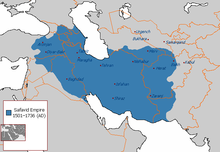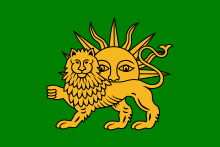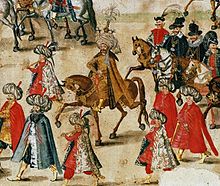Safavid dynasty
![]()
This article or section needs revision. More details should be given on the discussion page. Please help improve it, and then remove this tag.
![]()
This article is about the dynasty. For the Sufi Order, see Safawiyya.
The Safavids (Persian صفویان, DMG Ṣafawīyān; Azerbaijani صفویلر Səfəvilər) were a ruling dynasty in Persia, originating from Ardabil, who ruled from 1501 to 1722 and established Shia Islam as the state religion.

The Safavid Empire at its greatest territorial extent around 1510

Flag of Safavid Persia (Iran) under Shah Ismail II with lion and sun (Shir-o-khorshid).
Significance of the Safavids for modern Iran
The era of the Safavids had fundamental consequences for today's Islamic state. Under Ismail I, not only was it possible to unite areas and regions with a majority Iranian population, but the seeds of a Persian "national consciousness" were also sown, thus creating the basis for the Iranian state of today.
The Safavids forcibly converted large segments of the population to moderate Shiism, which set itself apart from the Sunnis who ruled in neighboring states. The Safavids were in perpetual conflict with the Ottoman Empire in the west. In the northeast, conflicts existed with the Uzbeks of the Janid dynasty. Intensive disputes were fought out at the same time in the east around today's Afghanistan. Opponents here were the influential Indian Great Moguls. The disputes increasingly required an articulated inner strength of the Persian consciousness.
This altogether gradual process eventually led to the emergence of different Islamic cultures, which in the 18th century then presented themselves as Persia, Central Asia and India under the Great Mughals.
History
The origins of the dynasty can be traced back to Sheikh Safi ad-Din Ardabili (1252-1334), who founded a Sufi order in Ardabil in 1301. This order became increasingly militarized from the middle of the 15th century (see also: Safawiyya). Under Shah Ismail I. (1484-1524) succeeded in 1501 the conquest of Tabriz and the fall of the Turkmen Aq Qoyunlu. The Turkmen tribes that supported the establishment of the subsequent Safavid Empire include the Afshar, Kajars, Teke, Humuslu, Şamli, Ustac, Dulkadir, and Varsaks. After the northeast of Iran had been secured with a victory over the Uzbeks at Herat (1510), conflict arose with the Ottomans in the west. The latter defeated the Safavids at Chaldiran in 1514 and captured the capital Tabriz. Under the Safavids, the League of the Kizilbash was formed, elite soldiers who initially consisted only of Turkmen and were later recruited from other sectors of the population. The Kizilbash gained much prestige and fame under the Safavids.
Also the successor, Tahmasp I. (1524-1576), was in conflict with the Ottomans and Uzbeks. While he was able to hold Khorasan against the latter, Iraq and Azerbaijan were lost to the Ottomans one after the other until 1534. In 1555, the Peace of Amasya established the new border with the Ottoman Empire.
After some dynastic turmoil, Abbas I the Great (1587-1629) achieved a consolidation of the empire. Under him Bahrain could be occupied in 1601. In 1603 the Ottomans could be driven out of Azerbaijan, Armenia and Georgia and in 1623 even Iraq with Baghdad was reconquered. This brought the Shiite pilgrimage centers of Najaf and Karbala back under Persian control. In 1595 the encroachments of the Uzbek Abdullah II were stopped. Through skillful economic administration, the country came to prosperity. This was reflected in the development of infrastructures, especially the new capital Isfahan, which now had an excellent road system and prestigious projects such as the Meidān-e Naqsh-e Jahan. Abbas I also limited the influence of the Turkmen military by building up troops from Christian slaves.
Under the successors of Abbas I, the central administration lost influence. Only under Shah Abbas II (1642-1666) did the empire reform and consolidate. Under his aegis, close trade contacts were established with the European maritime powers of England and Holland. In 1649, it was possible to occupy Kandahar in what is now southern Afghanistan, which was claimed by both Persia and the Indian Mughal Empire.
Towards the end of the 17th century, under Sultan Husain (reigned 1694-1722), there was a sharp economic decline. Since at the same time the Sunnis in the empire were to be forcibly converted to Shiite Islam, an uprising of the Pashtun Ghilzai broke out in 1719. These conquered Isfahan in 1722 and deposed the incumbent shah. This new Hotaki dynasty could only hold on for a few years. The son of the ruler, Tahmasp II, and his general Nadir Shah were able to drive out the invaders in 1729. But the Safavids (Tahmasp II and his son Abbas III) were puppets of the Afsharids. Thus, Nadir Shah put an end to the dynasty in 1736. In some provinces the Safavids (Ismail III) could hold on until 1773, but without actually holding power.

Safavid Empire and territorial losses

The Persian ambassador Mechti Kuli Beg enters Krakow, where he attends the wedding of King Sigismund III in 1605.
Search within the encyclopedia